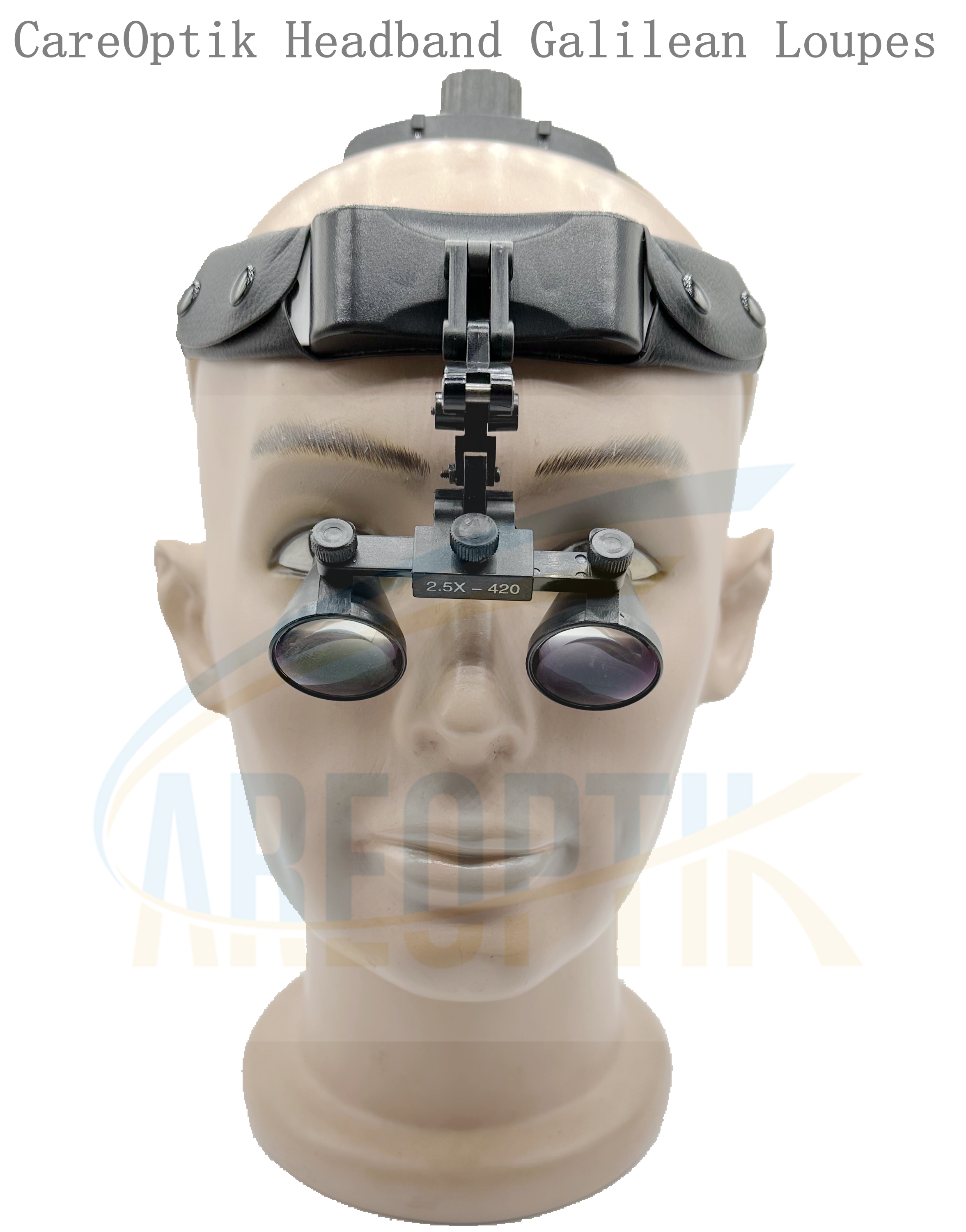How to choose dental loupes surgical loupes
When purchasing a new loupe, it is important for you to choose the correct magnification and working distance in order to ensure that you work in complete ergonomic harmony with your new loupe. Assuming the correct working posture reduces eye strain, back/shoulder/neck tension, and related stress-induced headaches. Less known but no less important is the psychological impact: good ergonomics improve information processing and decision-making.
1. loupes optics lens

The best method to evaluate loupes is to look at an object with straight black lines, as below in Fig.A. The most common signs of poor-quality loupes are low resolution, chromatic aberration, and spherical aberration.
Resolution is defined as an optical system's ability to form distinguishable images of objects separated by small distances, or to recognize fine detail. When comparing different loupes, look at the testing objects and select an area of tiny details that can only be seen with magnification.
Chromatic aberration refers to color distortion. Because each color has a different wavelength, uncorrected optics cause the various wavelengths to focus at different points in space. The first color that generally comes out of focus is blue; when looking at black lines on white paper, poor quality loupes will display a blue haze just to the side of the black lines, as depicted in Fig.B.
Spherical aberration is called to be the flatness of the image. When viewed through loupes, an object that exhibits spherical aberrations would appear to be curved or spherical, as depicted in Fig. B. The lines would not be straight, as in the original (Fig. A) or in the Careoptical loupes image of Fig. C.
Viewing colorful or complex objects such as anatomical models or the inside of your hand does not give you the opportunity to evaluate loupes for their true optical performance, as most people are not trained to see the differences in such complex images. A simple piece of graph paper, however, can reveal the difference between mediocre and high-quality loupes
2. Magnification:
The level of magnification used is most often based on personal preferences. However, there are a few guidelines that could help in choosing the best magnification for your specific needs.
Our first recommendation is to choose the lowest comfortable magnification level, as this would provide the widest field of view.
Experience shows that the most commonly used and recommended magnification for loupes in different dental fields are as follows:
1. loupes optics lens

The best method to evaluate loupes is to look at an object with straight black lines, as below in Fig.A. The most common signs of poor-quality loupes are low resolution, chromatic aberration, and spherical aberration.
Resolution is defined as an optical system's ability to form distinguishable images of objects separated by small distances, or to recognize fine detail. When comparing different loupes, look at the testing objects and select an area of tiny details that can only be seen with magnification.
Chromatic aberration refers to color distortion. Because each color has a different wavelength, uncorrected optics cause the various wavelengths to focus at different points in space. The first color that generally comes out of focus is blue; when looking at black lines on white paper, poor quality loupes will display a blue haze just to the side of the black lines, as depicted in Fig.B.
Spherical aberration is called to be the flatness of the image. When viewed through loupes, an object that exhibits spherical aberrations would appear to be curved or spherical, as depicted in Fig. B. The lines would not be straight, as in the original (Fig. A) or in the Careoptical loupes image of Fig. C.
Viewing colorful or complex objects such as anatomical models or the inside of your hand does not give you the opportunity to evaluate loupes for their true optical performance, as most people are not trained to see the differences in such complex images. A simple piece of graph paper, however, can reveal the difference between mediocre and high-quality loupes
2. Magnification:
The level of magnification used is most often based on personal preferences. However, there are a few guidelines that could help in choosing the best magnification for your specific needs.
Our first recommendation is to choose the lowest comfortable magnification level, as this would provide the widest field of view.
Experience shows that the most commonly used and recommended magnification for loupes in different dental fields are as follows:
|
Specialty
|
|
Magnification
|
|
General dentistry, Dental hygiene, Implant:
|
|
2.5x .3.0x. 3.5
|
|
Endo, Crown, and Bridgework:
|
|
3.5x - 4.0x
|
|
Lab work, Technician:
|
|
4.0x . 5.0x .6.0
|
* We suggest buyers don't choose too large magnification, normally. if lower magnification can fit you working, choose lower magnification for working because with larger magnification, the fields of view are smaller and the weight is heavier. so, if 2.5X magnification can meet your working, choosing 2.5X will be better.
3. Working distance:
The working distance refers to the distance between your eyes, and the patient's mouth.
You can measure this while assuming your normal working position, making sure you are comfortable, that your back is straight, and that you are not leaning forward too much. Perhaps you could ask someone to assist you in this procedure.
You can also use the following table to help determine the best working distance for your personal needs:
You can measure this while assuming your normal working position, making sure you are comfortable, that your back is straight, and that you are not leaning forward too much. Perhaps you could ask someone to assist you in this procedure.
You can also use the following table to help determine the best working distance for your personal needs:
|
Height
|
|
<170 cm (5ft 7 in)
|
170-190 cm (5ft 7 in to 6ft 4 in)
|
>190 cm (6ft 4 in)
|
|
Sitting
|
|
340 mm (14 in)
|
420 mm (16 in)
|
500 mm (20 in)
|
|
Standing
|
|
420 mm (16 in)
|
500 mm (20 in)
|
550 mm (22in)
|
4. Field of view
The field of view is the area that is visible & in focus while looking through the loupes.
A larger field of view is preferred, as there is a larger area visible through the loupes, and there is less need to move your head around.
The size of the "field of view" also corresponds directly to the magnification factor. Simply stated: A loupe with a lower magnification factor will have a larger field of view, and vice versa. All Loupes utilize high-performance lens systems that provide an extra wide field of view (up to 125mm / 4.9 inch).
A larger field of view is preferred, as there is a larger area visible through the loupes, and there is less need to move your head around.
The size of the "field of view" also corresponds directly to the magnification factor. Simply stated: A loupe with a lower magnification factor will have a larger field of view, and vice versa. All Loupes utilize high-performance lens systems that provide an extra wide field of view (up to 125mm / 4.9 inch).
5. Depth of view
The depth of field is the depth of the area that is visible & in focus while looking through the loupes.
A larger depth of field is preferred, as there is a deeper area visible through the loupes.
A larger depth of field is preferred, as there is a deeper area visible through the loupes.
The size of the "depth of field" corresponds directly to the "working distance".
Simply stated: A loupe with a longer working distance, will have a larger depth of field, and vice versa.
The size of the "depth of field" also corresponds directly to the magnification factor.
Simply stated: A loupe with a lower magnification factor, will have a larger depth of field, and vice versa.
All Loupes utilize high-performance lens systems that provide an extra large depth of field (up to 120mm / 4.7 inch).
Simply stated: A loupe with a longer working distance, will have a larger depth of field, and vice versa.
The size of the "depth of field" also corresponds directly to the magnification factor.
Simply stated: A loupe with a lower magnification factor, will have a larger depth of field, and vice versa.
All Loupes utilize high-performance lens systems that provide an extra large depth of field (up to 120mm / 4.7 inch).
7. Prescription Lenses:
If you use glasses with prescription lenses, it is important that you have the option of fitting your loupes frames with the correct prescription. Otherwise, the loupes will not perform according to specifications.
The standard frames can easily be fitted with prescription lenses by your optician. loupes are also available in a "clip-on" option, which can be clipped onto your regular glasses. regarding Care Optical loupes, we also can mount the prescription for you. our Flip Up style loupes (Ni-alloy frames or Titanium frames ) and Hybrid loupes can be mounted with prescription lenses.
If you use glasses with prescription lenses, it is important that you have the option of fitting your loupes frames with the correct prescription. Otherwise, the loupes will not perform according to specifications.
The standard frames can easily be fitted with prescription lenses by your optician. loupes are also available in a "clip-on" option, which can be clipped onto your regular glasses. regarding Care Optical loupes, we also can mount the prescription for you. our Flip Up style loupes (Ni-alloy frames or Titanium frames ) and Hybrid loupes can be mounted with prescription lenses.
8. The Weight Of The Loupes:
Weight is an important factor when choosing a new loupe. Especially if the loupe is to be used for longer periods of time.
Lightweight loupes are more comfortable, and in the long term, will reduce tension and other complications.
Ultra lightweight loupes offer maximal comfort. All Loupes utilize extremely lightweight materials. Loupes weigh as little as 42 grams (not including the frame)..the Normal TTL loupes are very very lighter and custom-made loupes .regarding the prismatic loupes are heavy. we also designed the headband style. that will be comfortable for users for a long time.
Weight is an important factor when choosing a new loupe. Especially if the loupe is to be used for longer periods of time.
Lightweight loupes are more comfortable, and in the long term, will reduce tension and other complications.
Ultra lightweight loupes offer maximal comfort. All Loupes utilize extremely lightweight materials. Loupes weigh as little as 42 grams (not including the frame)..the Normal TTL loupes are very very lighter and custom-made loupes .regarding the prismatic loupes are heavy. we also designed the headband style. that will be comfortable for users for a long time.
9. Pupil distance of the loupes
Just the custom-made TTL loupes will be concerned with the pupil distance, for another style, the pupil distance is adjustable. regarding the custom-made TTL loupes pupil distance, can check the article on TTL loupes pupil distance.
Just the custom-made TTL loupes will be concerned with the pupil distance, for another style, the pupil distance is adjustable. regarding the custom-made TTL loupes pupil distance, can check the article on TTL loupes pupil distance.































